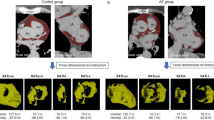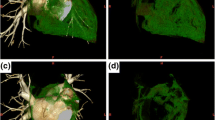Abstract
Purpose
Quantitative measurement of pericoronary adipose tissue volume (PCATV) and fat attenuation index (FAI) has mostly been used in the study of coronary artery related diseases but rarely in the relationship with atrial fibrillation (AF). This study was conducted to investigate the correlation of PCATV and FAI with the AF recurrence after ablation and the clinical significance.
Materials and methods
Patients with continuous AF who underwent radiofrequency ablation and computed tomographic angiography (CTA) were retrospectively enrolled. The PCATV, FAI, epicardial adipose tissue volume (EATV) and EAT density (EATD) arround the three main branches of the coronary arteries (LAD, LCX, and RCA) were measured quantitatively with cardiac function software and analyzed.
Results
189 patients with continuous AF who underwent radiofrequency ablation for the first time were enrolled. After 12-month follow-up with a mean follow-up time of 10.93 ± 0.16 months, 47 (24.9%) patients were confirmed to have AF recurrence. The 3 V-FAI (− 81.17 ± 4.27 vs. − 83.31 ± 4.59 HU, P = 0.005), LCX-FAI (median − 77 vs. median − 81HU, P < 0.001), EATV (median 141.14vs. median 125.39 ml, P = 0.010), and EATVI (median 70.77 vs. 66.73 ml/m2, P = 0.008) were significantly increased in the recurrence group. EATVI (OR 1.043, 95% CI 1.020–1.066) and LCX-FAI (OR 1.254, 95% CI 1.145–1.374) were two significant independent risk factors for AF recurrence. In the comparison of ROC, the predictive value of LCX-FAI (cut-off value of >− 81.5 HU, area under the curve (AUC) of 0.722) was higher than that of EATVI (cut-off value > 81.07 ml/m2, AUC of 0.630).
Conclusion
EATVI and LCX-FAI were related to recurrence of AF after ablation and have important clinical value in predicting the AF recurrence.



Similar content being viewed by others
References
Zhang Z, et al. Associations of anemia with death and major bleeding in patients with atrial fibrillation: a report from the Chinese atrial fibrillation registry study. Clin Cardiol. 2022;45(1):91–100.
Vinding NE, et al. Ischemic stroke severity and mortality in patients with and without atrial fibrillation. J Am Heart Assoc. 2022;11(4): e022638.
Kany S, et al. Outcomes in patients experiencing complications associated with atrial fibrillation ablation: data from the German ablation registry. Int J Cardiol. 2022;363:64–70.
Oka T, et al. Post-ablation left atrial function impacts long-term recurrence of atrial fibrillation after ablation. Heart Vessels. 2022;37(2):315–26.
Rattanawong P, et al. Surgical versus catheter ablation in atrial fibrillation: a systematic review and meta-analysis of randomized controlled trials. J Cardiovasc Electrophysiol. 2022;33(10):2152–63.
Benjamin MM, et al. Association of left atrial strain by cardiovascular magnetic resonance with recurrence of atrial fibrillation following catheter ablation. J Cardiovasc Magn Reson. 2022;24(1):3.
Huber AT, et al. The relationship between enhancing left atrial adipose tissue at CT and recurrent atrial fibrillation. Radiology. 2022;305(1):56–65.
Simon J, et al. Left atrial appendage size is a marker of atrial fibrillation recurrence after radiofrequency catheter ablation in patients with persistent atrial fibrillation. Clin Cardiol. 2022;45(3):273–81.
O’Neill L, et al. Clinical, electrophysiological and imaging predictors of atrial fibrillation ablation outcome. Expert Rev Cardiovasc Ther. 2017;15(4):289–305.
Wong CX, et al. Pericardial fat is associated with atrial fibrillation severity and ablation outcome. J Am Coll Cardiol. 2011;57(17):1745–51.
Tsao HM, et al. Quantitative analysis of quantity and distribution of epicardial adipose tissue surrounding the left atrium in patients with atrial fibrillation and effect of recurrence after ablation. Am J Cardiol. 2011;107(10):1498–503.
Nagashima K, et al. Association between epicardial adipose tissue volumes on 3-dimensional reconstructed CT images and recurrence of atrial fibrillation after catheter ablation. Circ J. 2011;75(11):2559–65.
Kocyigit D, et al. Periatrial epicardial adipose tissue thickness is an independent predictor of atrial fibrillation recurrence after cryoballoon-based pulmonary vein isolation. J Cardiovasc Comput Tomogr. 2015;9(4):295–302.
Goeller M, et al. Pericoronary adipose tissue CT attenuation and its association with serum levels of atherosclerosis-relevant inflammatory mediators, coronary calcification and major adverse cardiac events. J Cardiovasc Comput Tomogr. 2021;15(5):449–54.
Yuvaraj J, et al. Pericoronary adipose tissue attenuation is associated with high-risk plaque and subsequent acute coronary syndrome in patients with stable coronary artery disease. Cells. 2021;10(5):1143.
Hendriks JM, Heidbuchel H. The management of atrial fibrillation: an integrated team approach - insights of the 2016 European Society of Cardiology guidelines for the management of atrial fibrillation for nurses and allied health professionals. Eur J Cardiovasc Nurs. 2019;18(2):88–95.
Dai X, et al. Perivascular fat attenuation index and high-risk plaque features evaluated by coronary CT angiography: relationship with serum inflammatory marker level. Int J Cardiovasc Imaging. 2020;36(4):723–30.
Yu W, et al. Incremental value of epicardial fat volume to coronary artery calcium score and traditional risk factors for predicting myocardial ischemia in patients with suspected coronary artery disease. J Nucl Cardiol. 2022;29(4):1583–92.
Gorter PM, et al. Quantification of epicardial and peri-coronary fat using cardiac computed tomography; reproducibility and relation with obesity and metabolic syndrome in patients suspected of coronary artery disease. Atherosclerosis. 2008;197(2):896–903.
Oikonomou EK, et al. Non-invasive detection of coronary inflammation using computed tomography and prediction of residual cardiovascular risk (the CRISP CT study): a post-hoc analysis of prospective outcome data. Lancet. 2018;392(10151):929–39.
Qin B, et al. The predictive value of the perivascular adipose tissue CT fat attenuation index for coronary in-stent restenosis. Front Cardiovasc Med. 2022;9: 822308.
You D, et al. The correlation of pericoronary adipose tissue with coronary artery disease and left ventricular function. BMC Cardiovasc Disord. 2022;22(1):398.
Sun JT, et al. Pericoronary fat attenuation index is associated with vulnerable plaque components and local immune-inflammatory activation in patients with non-ST elevation acute coronary syndrome. J Am Heart Assoc. 2022;11(2): e022879.
Hu YF, et al. Inflammation and the pathogenesis of atrial fibrillation. Nat Rev Cardiol. 2015;12(4):230–43.
Park HW, et al. Neural mechanisms of atrial fibrillation. Curr Opin Cardiol. 2012;27(1):24–8.
Li B, et al. Pulmonary vein parameters are similar or better predictors than left atrial diameter for paroxysmal atrial fibrillation after cryoablation. Braz J Med Biol Res. 2019;52(9): e8446.
Schwartzman D, Lacomis J, Wigginton W. Characterization of left atrium and distal pulmonary vein morphology using multidimensional computed tomography. J Am Coll Cardiol. 2003;41(8):1349–57.
Girerd N, et al. Periatrial epicardial fat is associated with markers of endothelial dysfunction in patients with atrial fibrillation. PLoS ONE. 2013;8(10): e77167.
Nogami K, et al. Association between pericoronary adipose tissue attenuation and outcome after second-generation cryoballoon ablation for atrial fibrillation. Brit J Radiol. 2021;94:20210361.
Lang RM, et al. Recommendations for cardiac chamber quantification by echocardiography in adults: an update from the American society of echocardiography and the European association of cardiovascular imaging. Eur Heart J Cardiovasc Imaging. 2015;16(3):233–70.
Mahajan R, Lau DH, Sanders P. Impact of obesity on cardiac metabolism, fibrosis, and function. Trends Cardiovasc Med. 2015;25(2):119–26.
Mahajan R, et al. Electrophysiological, electroanatomical, and structural remodeling of the atria as consequences of sustained obesity. J Am Coll Cardiol. 2015;66(1):1–11.
Maurovich-Horvat P, et al. Comparison of anthropometric, area- and volume-based assessment of abdominal subcutaneous and visceral adipose tissue volumes using multi-detector computed tomography. Int J Obes (Lond). 2007;31(3):500–6.
Antonopoulos AS, et al. Detecting human coronary inflammation by imaging perivascular fat. Sci Transl Med. 2017. https://doi.org/10.1126/scitranslmed.aal2658.
Gaborit B, et al. Human epicardial adipose tissue has a specific transcriptomic signature depending on its anatomical peri-atrial, peri-ventricular, or peri-coronary location. Cardiovasc Res. 2015;108(1):62–73.
Iacobellis G, Corradi D, Sharma AM. Epicardial adipose tissue: anatomic, biomolecular and clinical relationships with the heart. Nat Clin Pract Cardiovasc Med. 2005;2(10):536–43.
Hannukainen JC, et al. Reversibility of myocardial metabolism and remodelling in morbidly obese patients 6 months after bariatric surgery. Diabetes Obes Metab. 2018;20(4):963–73.
Wong CX, et al. Associations of epicardial, abdominal, and overall adiposity with atrial fibrillation. Circ Arrhythm Electrophysiol. 2016. https://doi.org/10.1161/CIRCEP.116.004378.
Oba K, et al. Effect of the epicardial adipose tissue volume on the prevalence of paroxysmal and persistent atrial fibrillation. Circ J. 2018;82(7):1778–87.
Maeda M, et al. Usefulness of epicardial adipose tissue volume to predict recurrent atrial fibrillation after radiofrequency catheter ablation. Am J Cardiol. 2018;122(10):1694–700.
Mazurek T, et al. Relation of proinflammatory activity of epicardial adipose tissue to the occurrence of atrial fibrillation. Am J Cardiol. 2014;113(9):1505–8.
Kim HW, Belin de Chantemèle EJ, Weintraub NL. Perivascular adipocytes in vascular disease. Arterioscler Thromb Vasc Biol. 2019;39(11):2220–7.
Fitzgibbons TP, Czech MP. Epicardial and perivascular adipose tissues and their influence on cardiovascular disease: basic mechanisms and clinical associations. J Am Heart Assoc. 2014;3(2): e000582.
El Mahdiui M, et al. Posterior left atrial adipose tissue attenuation assessed by computed tomography and recurrence of atrial fibrillation after catheter ablation. Circ Arrhythm Electrophysiol. 2021;14(4): e009135.
Ciuffo L, et al. Periatrial fat quality predicts atrial fibrillation ablation outcome. Circ Cardiovasc Imaging. 2019;12(6): e008764.
Author information
Authors and Affiliations
Corresponding author
Ethics declarations
Conflict of interest
The authors declared that they have no conflict of interest in publication of this article.
Ethical approval
This study was approved by the Ethic Committee of The Second Hospital of Hebei Medical University, and all data have been approved to be published by the journal.
Additional information
Publisher's Note
Springer Nature remains neutral with regard to jurisdictional claims in published maps and institutional affiliations.
About this article
Cite this article
Ma, Gj., Guo, Fq., Hu, J. et al. Association of pericoronary adipose tissue with atrial fibrillation recurrence after ablation based on computed tomographic angiography. Jpn J Radiol 41, 955–964 (2023). https://doi.org/10.1007/s11604-023-01426-x
Received:
Accepted:
Published:
Issue Date:
DOI: https://doi.org/10.1007/s11604-023-01426-x




